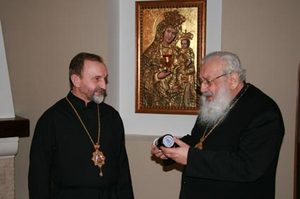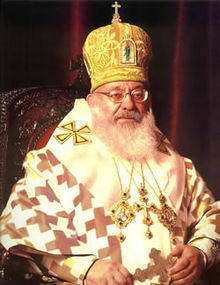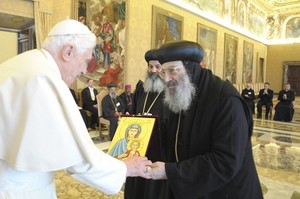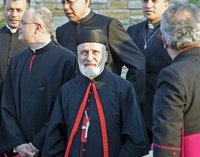In honor of the 1600th anniverssary of the death of Saint Maron, the Holy Father Pope Benedict XVI blessed and unveiled a new statue of the saint at the Vatican basilica of Saint Peter’s.
For the past year, Maronites and others around the world have been observing a jubliee year called by His Beatitude, Patriarch Nasralla Peter Sfeir. In a letter to the Maronite Church around the world he said, in part,
Our Church was not built after a name of a See or Apostle, but rather took its identity from the radiance of a man and a monastery: the Maronite Church, a Church of asceticism and adoration attached from the beginning to a solitary man, not a man of rank or a Church leader.
The faith lived out by the hermit Maron became the inner strength of a people’s history. As for the successive migrations from Syria (in the 5-10th centuries), the Maronites gave them one meaning, that is, giving up land, wealth and comfort in Syria moving toward a poor land where anxiety and austerity prevail, so they could preserve their faith and remain attached to their freedom … This event is not a simple historical fact among others … it is the very beginning of a new history, the history of the Maronites.
The Jubilee Prayer
Lord, Jesus, You called Your chosen one, Saint Maron, to the monastic life, perfected him in divine virtues, and guided him along the difficult road to the heavenly kingdom.
During this jubilee year, commemorating 1600 years since the death of Your chosen one, Saint Maron, when he was called to the house of Your heavenly Father, we ask You, through his intercession, to immerse us in Your love that we may walk in Your path, heed Your commandments, and follow in his footsteps.
May his holy example resonate throughout our lives. With Your love, may we achieve that final distination reached by our father, Saint Maron, and carry Your Gospel throughout the world.
Through his intercession, may we attain the glory of the resurrection and everlasting life in You.
Glory and thanks are due to You, to Your blessed Father, and to Your living Holy Spirit, now and forever. Amen.
 In the past weeks we’ve seen the Pontiff accepting the resignation of His Beatitude Cardinal Lubomyr Husar, 78, as the Major Archbishop of the Ukrainian Catholic Church. Bishop Ihor Voznyak is the temporary administrator of the Church until a new leader is elected.
In the past weeks we’ve seen the Pontiff accepting the resignation of His Beatitude Cardinal Lubomyr Husar, 78, as the Major Archbishop of the Ukrainian Catholic Church. Bishop Ihor Voznyak is the temporary administrator of the Church until a new leader is elected.





